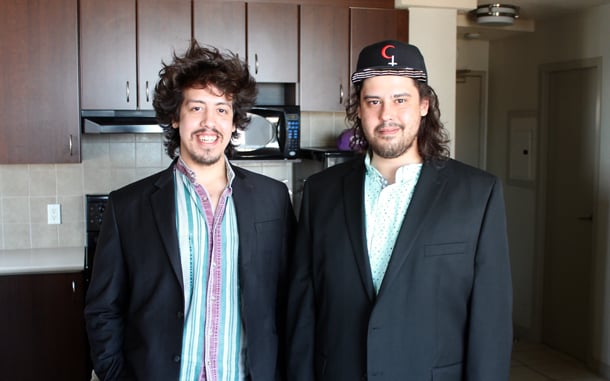''Once this land couldn't even be owned,'' says the narrator of INAATE/SE/ early on. His statement quickly gains forceful significance as descriptions and images of colonial violence appear on screen.
Filmmakers (and brothers) Adam and Zack Khalil don't mince words in their provocative feature debut, laying bare the dark legacy of colonialism and the endurance of the Ojibwa nation in the face of such a devastating history.
The film had its Canadian premiere at the DOXA Documentary Film Festival in Vancouver yesterday and plays again tonight.
INAATE/SE largely takes place on the brothers' ancestral home territory of Sault Ste. Marie, which straddles the border between the U.S. and Canada.
The two Saults (one in Michigan, the other in Ontario) seem like a perfect symbol of what the brothers seek to unpack. A colonial border bisects the territory, and both cities were named for the mother of Christ by the Jesuit missionaries who took over, overwriting so much of Ojibwa history.
In the film, the Khalil brothers insert their own perspectives into already well-established versions of history. Their interventions sometimes involve literally rearranging interview content, or remixing archival footage to radically change meanings.
A video regularly played at the Chippewa County Historical Society is warped, re-edited so that a quaint description of the Jesuit mission to Sault Ste. Marie becomes a disturbingly low-key admission of genocide. The image of a fatherly missionary jumps and flickers as his address to us is noticeably rearranged and overwritten by the Khalils.
The filmmakers take us through some of the many harms committed by settlers -- theft, abuse, murder, residential schools -- while also shedding light on the contemporary realities of their subjects.
The Seven Fires Prophecy of the Ojibwa takes centre stage. These ancient stories have been passed down for generations and tie together the film's different narrative threads. They're used to interpret major events and rather eerily foretold much of the legacy of colonialism, providing a great entry-point into many personal and communal stories.
The blending of vérité style documentary, animation, video remixing, archival images, and green-screen psychedelia makes for an engagingly original piece of storytelling, fighting against the constraints of ''traditional'' documentary form.
The Tyee sat down with Adam and Zack to find out more about how the film came to be and how they chose to tackle such challenging subject matter. The interview has been condensed and edited for clarity.
The Tyee: What's the importance of the Seven Fires Prophecy for you?
Zack: It's such an important story for Ojibwa people and it's been passed down forever and ever and recreated in different iterations, the most recent one being The Mishomis Book by Eddie Benton-Banai, who's an Ojibwa academic and spiritual leader. He was really active in the American Indian Movement in the 1970s.
Adam: The Mishomis Book was intended to be a children's book. Now it's a primary source text in a lot of academic work because it's the only thing that's published. Obviously these stories exist in other ways.
Zack: Passed between people, primarily.
Adam: So that was the version of the Seven Fires Prophecy that we used. And that's probably the version most people talk about now.
Zack: There are regional variations depending on who's telling the story and from where. It seemed important to have it structure the film. It determined how we deal with time and history in the film. It's a prophetic story that gets continually updated, so each fire changes and adapts to meet the needs of what has happened recently. And so for us it seemed important to continue that cycle. It's just sort of a way to reference the circularity of time and how all of those brutal actions of colonialism have influenced life for Ojibwa community today.
Adam: And the prophecy is flexible and changes based on what the story needs to tell to the people at the time. We're trying to update it.
What was it like telling a regional story with such universal implications surrounding colonialism and showing it in New York and now Vancouver?
Zack: In New York we presented the film with Audrey Simpson, a Mohawk scholar. It was really interesting to hear her take on the film coming from her Mohawk perspective, thinking about it as a very Ojibwa way of telling a story. I think the same themes and that history of colonialism resonates across the board. But we're presenting it in a specifically Ojibwa context.
Adam: And what's resonating across the board in this universal way is thinking about anthropology and ethnography as tools of colonialism. Native cultures today have to authenticate themselves with the past as opposed to being allowed to exist in the present or have culture. They have to have tradition because some ethnographer wrote, ''This is what these people do'' in 1700. I feel like there's this constant push to go back to the 1700s. That's not really an option. We're trying to totally negate that and move past it in the film.
It's a very self-reflexive film. You point back to yourselves and your own interventions into existing texts. Was it important to make yourselves visible in this way?
Zack: I think, for us, it would be foolish and misleading to tell the story from some sort of objective perspective.
Adam: It's a super reactionary film. It doesn't get much more reactionary. It's messy, it's angry, and it's in reaction to the colonial project that's ongoing in North America.

Zack: And it's a really personal film too in terms of the people who are featured. They're friends and family of ours, and so it was important for us to be present in the film in some way, otherwise it would feel like a lot of effort to obscure it, which seems disingenuous.
What's the role of humour in a film like this?
Adam: For our tribe specifically, the role of the trickster is really important. Like "Wild Bill," the guy [in the film] who's kind of a recluse. He's a great example of the trickster because he's doing what he needs to do and détourning everyone else's understanding of what he should be doing.
Zack: In order to cope with this history, you have to be able to make fun of it to a certain extent. And especially the insanity of the colonial side of it.
The humour also has a way of making us uncomfortable. I felt uncomfortable by how darkly funny some moments were.
Adam: Cool! It worked.
Zack: Those two things are more powerful when they sit together. Because they displace the audience in terms of what they know or understand, how they should be feeling or what they should be thinking.
What does the title mean?
Zack: There are different ways of translating Ojibwa. There's a sort of hard literal translation, and then there's a new school of thought where you can break words down into syllables, and each syllable has a very specific meaning that constructs the actual word.
Adam: Each syllable is a word. Everything's an action. So all words are just a string of actions put together.
Zack: So, INAATE/SE/ in the really straightforward translation is just "it's a certain kind of movie," but when you break it down it's "it shines a certain way, to a certain place. It flies, it falls." Which has a few meanings for us. I think the real literal meaning describes the basic mechanism of film projection. And then for us it has a particular resonance. "It shines a certain way to a certain place," that place is Sault Ste. Marie. That place is home. And "it flies, it falls" refers to the spontaneous nature of the film's creation. We followed the film. We had all these people we wanted to talk to -- our friends, our family -- and we had this prophecy, but it was a process that we just had to follow as opposed to something that we dictated.
What is it like working on a film like this that straddles a colonial national border? Is it both Canadian and American?
Zack: I think it's an Ojibwa film. And being an Ojibwa film, it doesn't acknowledge the distinction between the two.
Adam: It's an imaginary line. Those distinctions are irrelevant. They're relevant to our lives on a daily basis. It's actually really stupid. Our tribe is recognized by the federal U.S. government. It's called the Sault Ste. Marie Tribe of Chippewa Indians. The tribe on the other side of the river is Garden River, which is the First Nations tribe recognized by the Canadian government, in this paternalistic, condescending way. But it's the same fucking tribe.
Zack: It does add an extra dimension to the film because we get to make that distinction.
What do you hope audiences will get out of the film?
Zack: I hope they come away feeling like they know a lot less than they did when they came in, if that makes sense.
Adam: That's a good line.
Zack: I feel like we tell people a lot but we're really just opening the door to this world that most people, through our educational system and our culture, have decided to ignore or don't even know exists in the first place -- this entire conception of what history is that people have no idea about because it's been ruthlessly and brutally suppressed for the past 400 years. I hope they walk away learning something but feeling like there's a lot more to learn.
Adam: The other thing I'd say too is that films about Native peoples or films made by Indigenous people don't have to suck. They don't have to be this poverty porn thing. It's not like everybody has an SUV and a nice house, but there are different ways that people are empowered in these places. I think that's really important. ![]()
Read more: Indigenous, Film















Tyee Commenting Guidelines
Comments that violate guidelines risk being deleted, and violations may result in a temporary or permanent user ban. Maintain the spirit of good conversation to stay in the discussion.
*Please note The Tyee is not a forum for spreading misinformation about COVID-19, denying its existence or minimizing its risk to public health.
Do:
Do not: